Overview of American Gunboats in ww1
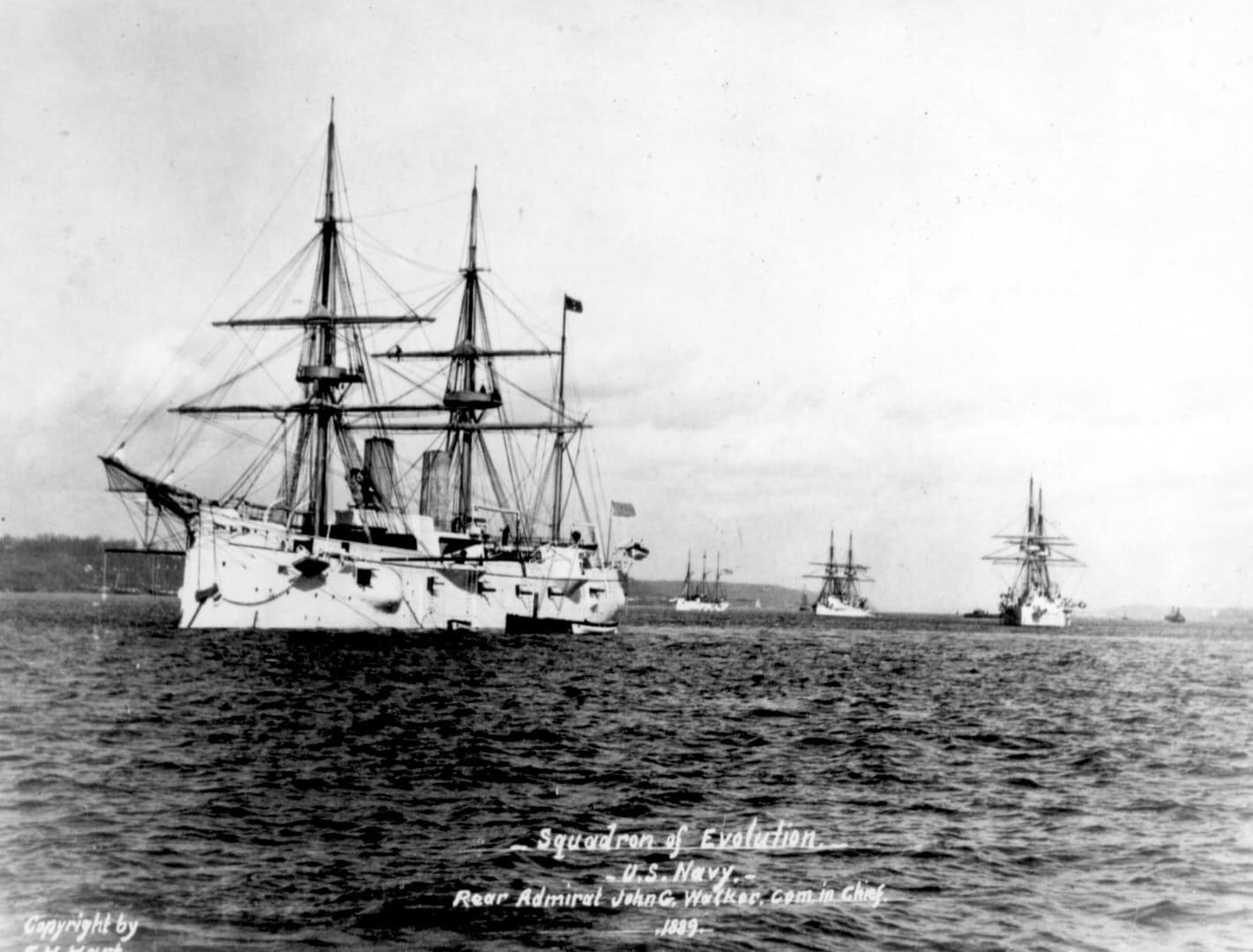
Among the first ships built for the “new navy”, the “old” one being the one built by the Union to blockade the Confederate states in 1861-65, the Dolphin and the ships that followed has been seen as cheap alternative to cruisers.
They were, in fact, small protected cruisers, which duty was essentially to “show the flag” on distant overseas stations, freeing the main fleet to be available for large scale oceanic actions.
So these gunboats (and its there only the ocean-going ones, not the riverine gunboats of that era) saw a lot of the world, most participated in the war of 1898 before ww1. They often featured near-obsolete barquentine rigging like most foreign ships of the same type because of the lack of coaling facilities far from home waters.
They also had a long carrier, through the interwar and up to ww2 for some, often converted as school ships, revenue cutters and coast guards depending of a Secretariat of State and not the Navy. Also included in this chapter are captured Spanish gunboats, often of small tonnage, in the Philippines and Cuba as a result of the “splendid little war” of 1898.
USS Dolphin (1886)
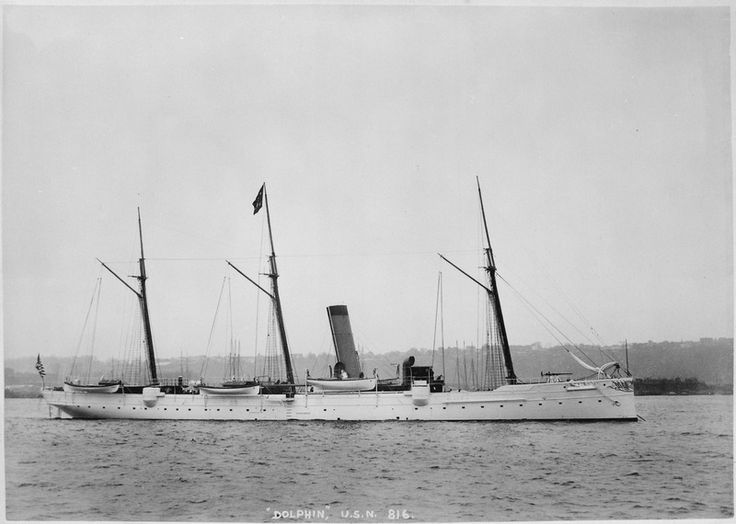
First ship of the “new navy” she was authorized under the act 3.3.1883, at first classified as a dispatch boat, with light barque rig with no head gear, later rigged as a three-masted schooner, and then reduced to two masts. She served for most of her career as a dispatch ship for the secretary of the Navy. Its upper deck forecastle 6 in had a full traverse, later replaced by two 4in/40 QF guns each side, and its artillery reduced to one 6-pdr (47mm) and six 3-pdr (37mm)
-Displacement & Dimensions: 1486 tons, 78 x 9.7 x 4.3m
-Propulsion: 4 cyl boilers, 1 shaft VC, 2255 ihp 16 kn.
-Crew: 152
-Armament (origin): 6 x 6in/30 (152mm), 2 x 6-pdr (76mm), 4 x 47mm revolver
Yorktown class gunboats (1889)
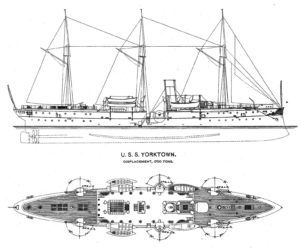
The Yorktown class units, initially classified as light cruisers, had a comfortable armament. The other two units of this class, Concord and Bennington, were put into service in 1891. The first was reclassified as an all-purpose ship, then a depot ship, and finally a customs ship from 1914. The USS Bennington suffered a terrible fire from Boilers in 1905 and was removed from the lists and sold in 1910.
-Displacement & Dimensions: 1700 tons and 1920 pcs, 74.52 x 10.97 x 4.27m
-Propulsion: 4 boilers, 2 propellers, 3400 hp. And 16 nodes max.
-Crew: 200
-Armament (origin): 6 x 4in (127mm), 4 guns x 3in (76mm), 2 x 6pdr (47mm), 4 x 37mm.
Petrel class gunboats (1888)
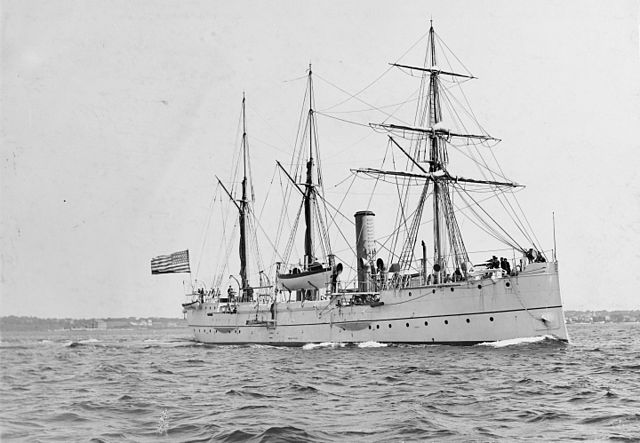
The Petrel and Bancroft were barquentine-rigged. The former had later its mainmast removed and armament reduced to 4 x 4in/40 QF guns. Originally the guns were mounted in sponsons before the forecastle and poop. On the USS Bancroft (which was lighter at 839 tonnes), guns were mounted port and starboard between the forecastle and poop. She became a revenue cutter Itasca and TTs were removed in 1899.
-Displacement: 867 tons, 900 FL
-Dimensions: 57.3 x 9.44 x 3.5m
-Propulsion: 4 cyl. boilers, 1 propeller, 1000 ihp, 11.4 kn max.
-Crew: 200
-Armament (origin): 6 x 4in (127mm), 4 x 3in (76mm), 2 x 6pdr (47mm), 4 x 1pdr (37mm)
Machias class gunboats (1891)

The two USS Machias and Castine gunboats were real small cruisers, designed for long crossings. They were commissioned in 1893 and 1894, but never fired a shot in anger, and spent a peaceful career without notable story during the Great War.
USS Castine served as submersible tanker from 1909, her armament reduced. The Machias was sold to the Mexicans in 1920, which employed her until 1935.
-Displacement & Dimensions: 1045 tons, 62 x 4.6 x 4 m
-Propulsion: 4 Babcock boilers, 2 propellers, 1250 hp and 16 knots max.
-Crew: 198
-Armament: 6 x 4in (127 mm), 4 x 3in (76mm), 2 x 1pdr (37mm)
USS Nashville (1895)
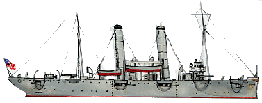
The USS Nashville was a high-tonnage patrol gunboat designed to serve the coasts of South America and the Gulf of Mexico. After a career without history, it was canceled in 1921.
-Displacement: 1085 tons
-Dimensions: 62 x 4.6 x 4 m
-Propulsion: 2 Babcock boilers, 2 propellers, 1250 hp and 13 knots max.
-Crew: 198
-Armament: 6 x 4in (120 mm), 4 x 3in (76mm), 2 x 1pdr (37mm)
Wilmington class gunboats (1895)
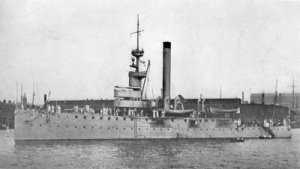
The large patrol boats Wilmington and Helena had a good habitability and considerable artillery. The first survived as a training vessel under the name of IX-30 Dover until 1946, the second was struck off in 1932. They had a low draft and could therefore operate on the rivers.
-Displacement 1400/1700 tons FL
-Dimensions 76,42 x 12,47 x 2,74 m
-Propulsion: 6 boilers, 2 screws, 1900 hp 15 knots.
-Crew: 199
-Armament: 6 x 127 mm, 4 x 76mm, 4 x 37mm
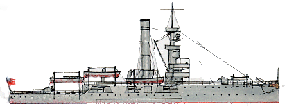
Illustration of the Wilmington class
Annapolis class gunboats (1896)
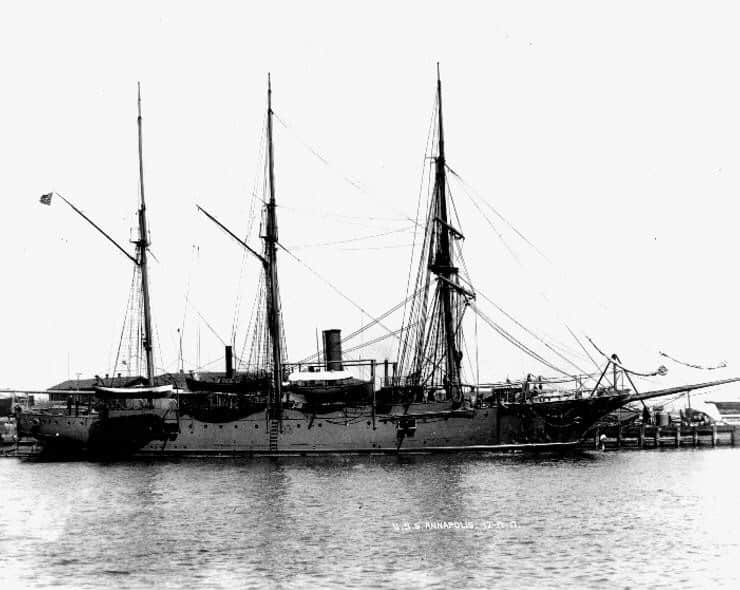
Four ships total: Annapolis, Vicksburg, Newport and Princeton, authorized 2.3.95, laid down as PG-10-13 in 1896, launched in December the same year and commissioned in 1897 (may 98 for Princeton).
Originally they were barquentine-rigged, with a clipper bow and long bowsprit, like composite-built vessels assimilated as sloops. 4 in guns (120 mm) were mounted fore and aft on the upper deck, reductions were later made, down to six 4-in guns in 1919.
Annapolis participated in the 1898 Spanish-American war, 15th conferred with a group of friendly Cubans and engaged in a brief gun duel with an enemy shore battery near the eastern end of the Baracoa, and later resumed duty at Guantanamo Bay.
She participated in the Battle of Nipe Bay, assisted landings at Puerto Rico, and later the Far Eastern fleet. Refitted at Mare Island, California in 1907. Then based at Tutuila, American Samoa. She was decommissioned in 1911, recommissioned in 1912 to participate in the coast of Nicaragua events. She then patrolled the Mexican coast as “Pancho” Villa was most active. She was part of the American Patrol in 1918, based in Louisiana. Then she joined the Pennsylvania Nautical School was served there until 1940.
-Displacement 1400/1700 tons FL
-Dimensions 76,42 x 12,47 x 2,74 m
-Propulsion: 6 boilers, 2 screws, 1900 hp 15 knots.
-Crew: 199
-Armament: 6 x 127 mm, 4 x 76mm, 4 x 37mm
Wheeling class gunboats (1896)
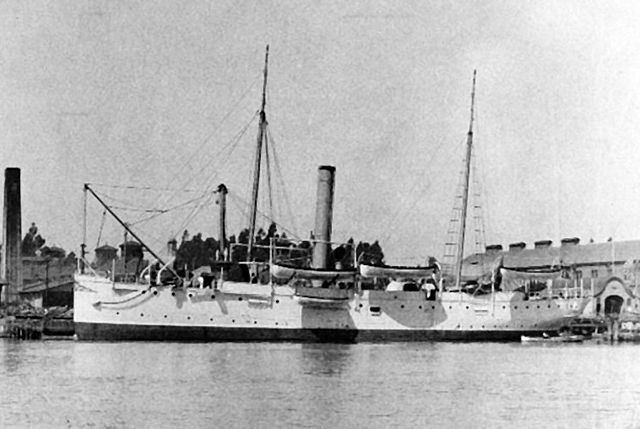
Launched at Union Iron Works in march 1896, and completed in September and October 1897.
-Displacement: 1700 tons and 1920 FL
-Dimensions: 74.52 x 10.97 x 4.27m
-Propulsion: 4 boilers, 2 propellers, 3400 hp. And 16 nodes max.
-Crew: 200
-Armament (origin): 6 guns of 127mm, 4 guns of 76mm, 2 of 47mm, 4 of 37mm.
USS Topeka (1881)
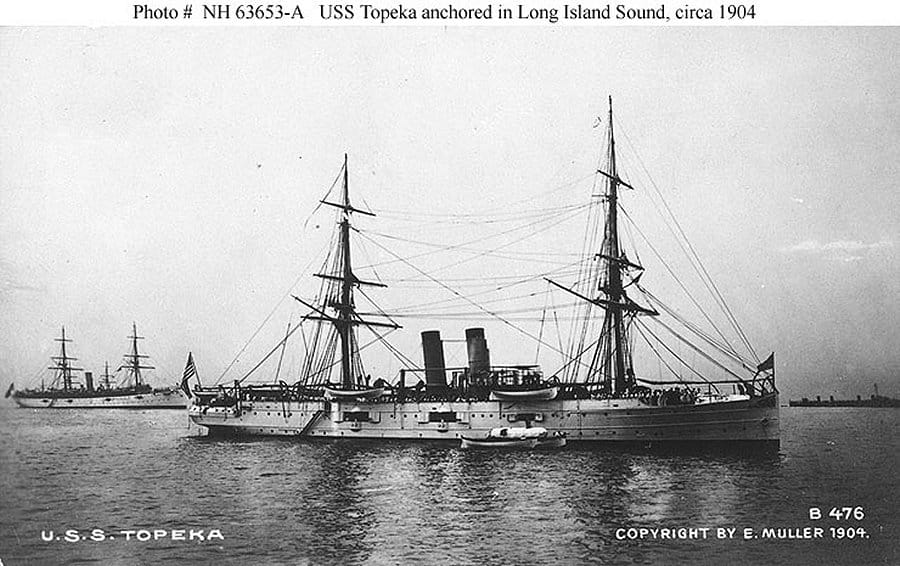
Former SS Diogenes purchased 22.4.1898 from Thames Iron works, and was a two-funneled, two-masted schooner, with iron hull, classed by the British as an unarmoured cruiser. Her initial provision of six 4in guns was later reduced to four. She was recommissioned in US service in June 1898 and became a prison ship in 1907.
-Displacement: 2372 tons
-Dimensions: 76 x 10.66 x 5.41 m
-Propulsion: 4 cyl boilers, 2 shaft HTC, 2200 ihp, 16 knts.
-Crew: 152
-Armament (origin): 8 x 4in (127mm), 2 x 6pdr (76mm), 2 x 3pdr (47mm), 2 x 1pdr (37mm)
Isla de Luzon class (1886)
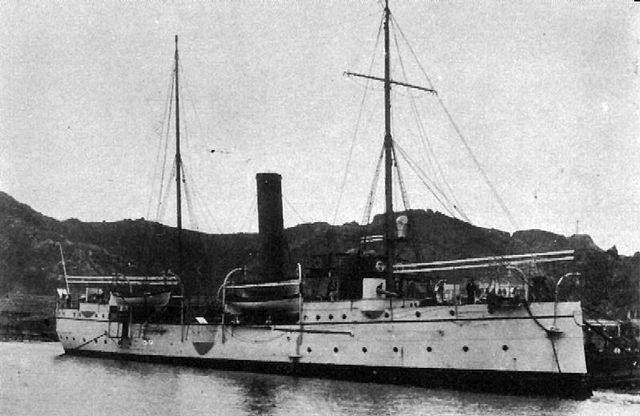
Captured Spanish gunboats. Both scuttled at the battle of Manila, salved, repaired, and pushed in US service bu 1900. Its original armament comprised 4-in guns on the forecastle, poop and a deck protected by 2-1/2 to 1 inch of armour.
Babcock and Wilcox Boiler were fitted in 1911. This ship served with the Louisiana and Illinois naval militias and after 1918 became a naval torpedo station as a yard craft. The Isla de Cuba was scuttled at the battle of Manilla. Recommissioned in January 1911. Quite similar to Isla de Luzon, they were near sister-ships. She was sold to Venezuela in 1912 and renamed Mariscal Sucre, surviving to ww2.
-Displacement: 1020 tons
-Dimensions: 59.4 x 9.14 x 3.47m
-Propulsion: 2 cyl boilers, 2 shaft VTE, 535ihp, 16 knts.
-Crew: 137
-Armament: 4 x 4in/40 (127mm), 4 x 6pdr, 3 TT 457mm aw.
Don Juan De Austria (1887)
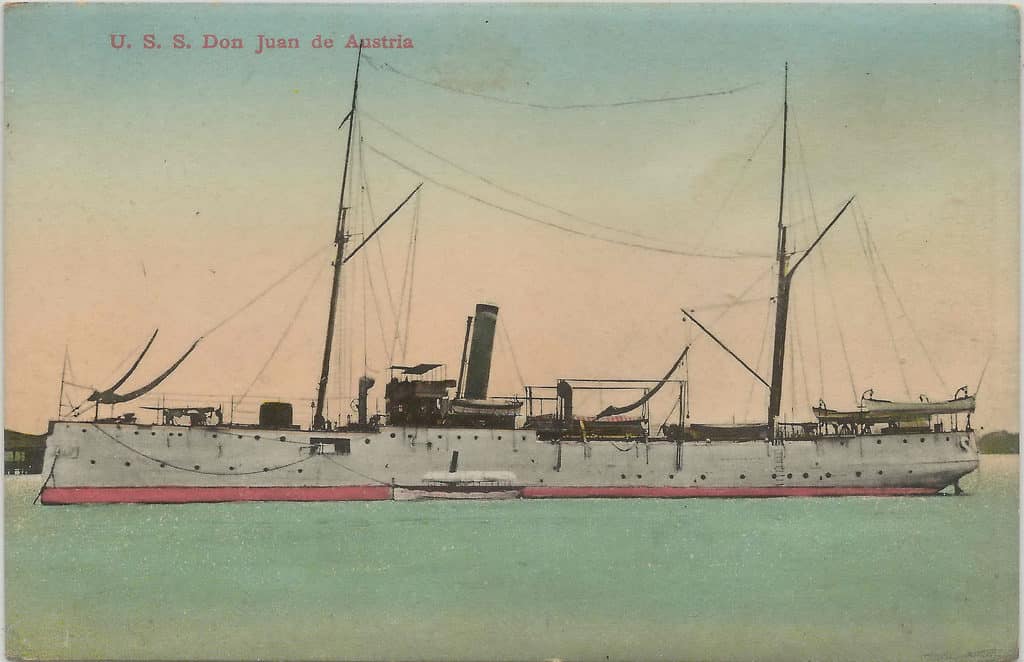
Protected cruiser built at Cartagena, Spain (the two above were from Armstrong), for colonial service. Sunk at the battle of Manila, salved, repaired. She has been recommissioned in 1900, and her main armament was modified to four 4in/40 QF guns, and she served with the Michigan naval militia from 1907 up to 1917. She was sold for scrap in 1919.
-Displacement: 1700 tons and 1920 FL
-Dimensions: 74.52 x 10.97 x 4.27m
-Propulsion: 4 boilers, 2 propellers, 3400 hp. And 16 nodes max.
-Crew: 200
-Armament: 6 guns of 127mm, 4 guns of 76mm, 2 of 47mm, 4 of 37mm.
Dubuque class gunboats (1904)
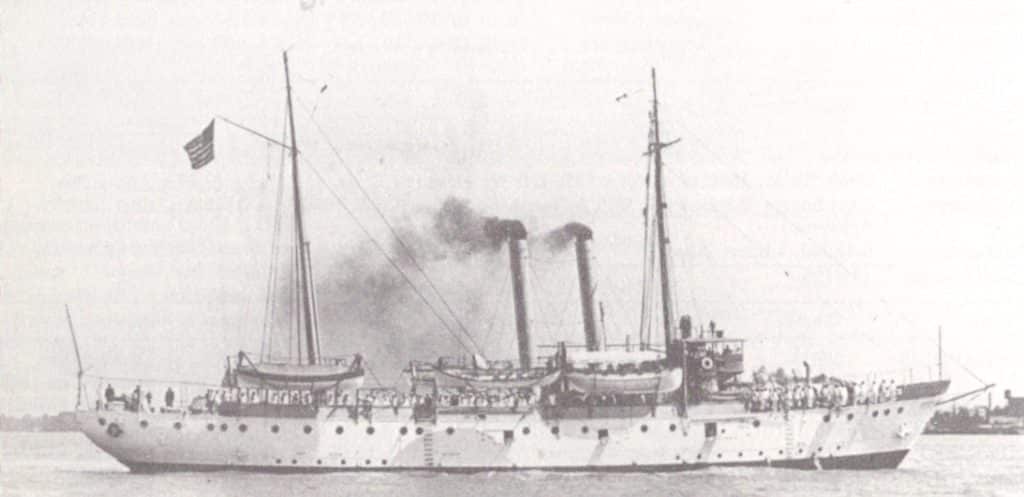
Authorized under act 1.7.1902, they were modern two-funneled, two-masted (with much reduced rigging), with a composite hull, bowsprit, and rated as sloops. Both PG17 and PG18 (“Patrol Boat”) has been built at Gas engine & Power and CL. Seabury, completed in june 1905. The 4in guns were mounted port and starboard on the upper deck.
Served on the great lakes from 1922, with their armament reduced and from 1940s, passed onto the cadets naval reservists, but employed actively as armed guards for merchant shipping on the Great lakes, numbered IX-9 and IX-23. Both were sold in 1946 as scrap metal.
-Displacement: 1084 tons
-Dimensions: 61 x 10.6 x 4m
-Propulsion: 2 B&W boilers, 2 shaft VTE, 1250 ihp, 13 knts.
-Crew: 184
-Armament: 6 x 4in/50 Mk7 (127mm), 4 x 6-pdr (76mm), 2 x 1pdr (37mm).
Small gunboats (ex-Spanish) (1886-95)
These 17 ships from various builders (Clydeband, Manila ship. co., Cavite, Hong Kong and Whampoa, had a displacement ranging from 106 (Alvarado) to 370 tons (Villalobos), a top speed limited to 7-11 knots (19 for Alvarado), armed often with a unique 6-pdr (76 mm) or one or two 3-pdr and a complement of 1-pdrs in some cases. All were taken in the Philippines and commissionned from 1899 to 1902. They served as coastal patrol boats until sold 1911-1933, some used as targets.
They kept their original names and were listed as Albay, Alvarado, Arayat, Calamianes, Callao, Ectano, Leyte, Manileno, Mariveles, Mindoro, Pampanga, Panay, Paragua, Quiros, Samar, Sandoval, and Villalobos. Interestingly enough, the second USS panay was involved in an incident, a Japanese attack while it was anchored in the Yangtze River outside Nanking, China on 12 December 1937. A famous movie with Steve McQueen was later inspired by this story.
Links
The Gunboats on wikipedia
About USS Petrel on navsource
-Conway’s all the world fighting ships 1860-1905 and 1906-1921.

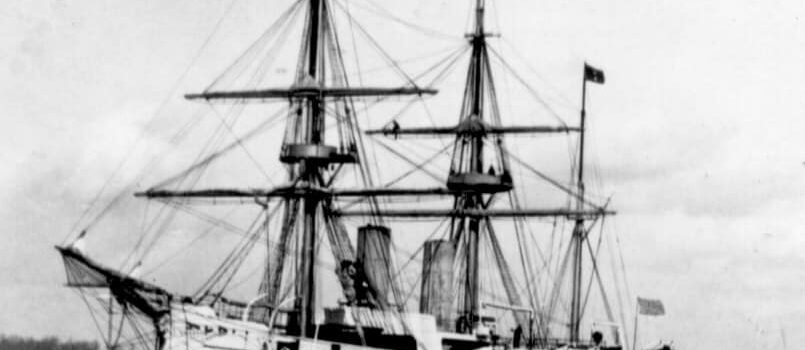

 Latest Facebook Entry -
Latest Facebook Entry -  X(Tweeter) Naval Encyclopedia's deck archive
X(Tweeter) Naval Encyclopedia's deck archive Instagram (@navalencyc)
Instagram (@navalencyc)





 French Navy
French Navy Royal Navy
Royal Navy Russian Navy
Russian Navy Armada Espanola
Armada Espanola Austrian Navy
Austrian Navy K.u.K. Kriegsmarine
K.u.K. Kriegsmarine Dansk Marine
Dansk Marine Nautiko Hellenon
Nautiko Hellenon Koninklije Marine 1870
Koninklije Marine 1870 Marinha do Brasil
Marinha do Brasil Osmanlı Donanması
Osmanlı Donanması Marina Do Peru
Marina Do Peru Marinha do Portugal
Marinha do Portugal Regia Marina 1870
Regia Marina 1870 Nihhon Kaigun 1870
Nihhon Kaigun 1870 Preußische Marine 1870
Preußische Marine 1870 Russkiy Flot 1870
Russkiy Flot 1870 Svenska marinen
Svenska marinen Søværnet
Søværnet Union Navy
Union Navy Confederate Navy
Confederate Navy Armada de Argentina
Armada de Argentina Imperial Chinese Navy
Imperial Chinese Navy Marinha do Portugal
Marinha do Portugal Mexico
Mexico Kaiserliche Marine
Kaiserliche Marine 1898 US Navy
1898 US Navy Sovietskiy Flot
Sovietskiy Flot Royal Canadian Navy
Royal Canadian Navy Royal Australian Navy
Royal Australian Navy RNZN Fleet
RNZN Fleet Chinese Navy 1937
Chinese Navy 1937 Kriegsmarine
Kriegsmarine Chilean Navy
Chilean Navy Danish Navy
Danish Navy Finnish Navy
Finnish Navy Hellenic Navy
Hellenic Navy Polish Navy
Polish Navy Romanian Navy
Romanian Navy Turkish Navy
Turkish Navy Royal Yugoslav Navy
Royal Yugoslav Navy Royal Thai Navy
Royal Thai Navy Minor Navies
Minor Navies Albania
Albania Austria
Austria Belgium
Belgium Columbia
Columbia Costa Rica
Costa Rica Cuba
Cuba Czechoslovakia
Czechoslovakia Dominican Republic
Dominican Republic Haiti
Haiti Hungary
Hungary Honduras
Honduras Estonia
Estonia Iceland
Iceland Eire
Eire Equador
Equador Iran
Iran Iraq
Iraq Latvia
Latvia Liberia
Liberia Lithuania
Lithuania Mandchukuo
Mandchukuo Morocco
Morocco Nicaragua
Nicaragua Persia
Persia San Salvador
San Salvador Sarawak
Sarawak Uruguay
Uruguay Venezuela
Venezuela Zanzibar
Zanzibar Warsaw Pact Navies
Warsaw Pact Navies Bulgaria
Bulgaria Hungary
Hungary

 Bundesmarine
Bundesmarine Dutch Navy
Dutch Navy Hellenic Navy
Hellenic Navy Marina Militare
Marina Militare Yugoslav Navy
Yugoslav Navy Chinese Navy
Chinese Navy Indian Navy
Indian Navy Indonesian Navy
Indonesian Navy JMSDF
JMSDF North Korean Navy
North Korean Navy Pakistani Navy
Pakistani Navy Philippines Navy
Philippines Navy ROKN
ROKN Rep. of Singapore Navy
Rep. of Singapore Navy Taiwanese Navy
Taiwanese Navy IDF Navy
IDF Navy Saudi Navy
Saudi Navy Royal New Zealand Navy
Royal New Zealand Navy Egyptian Navy
Egyptian Navy South African Navy
South African Navy






























 Ukrainian Navy
Ukrainian Navy dbodesign
dbodesign